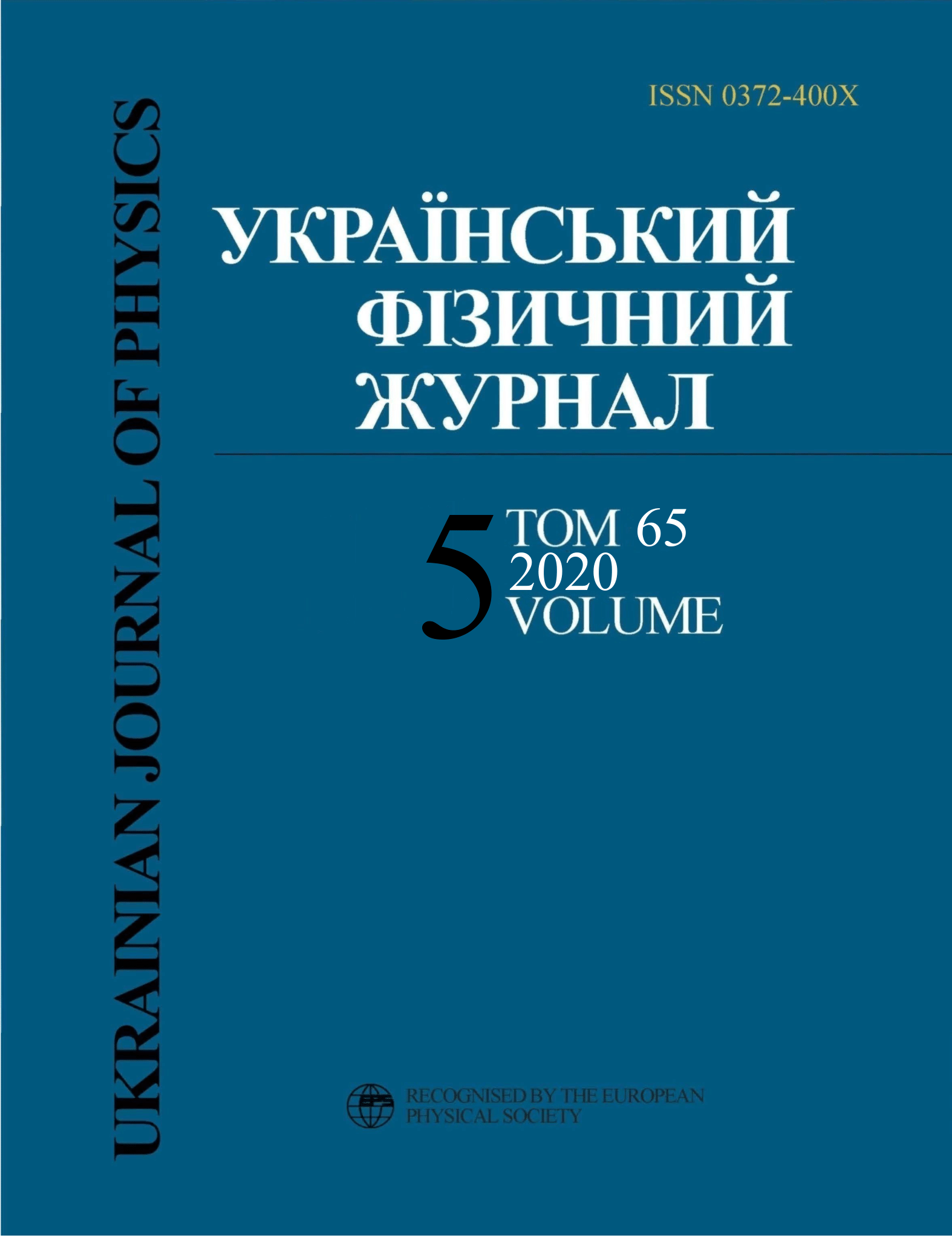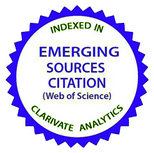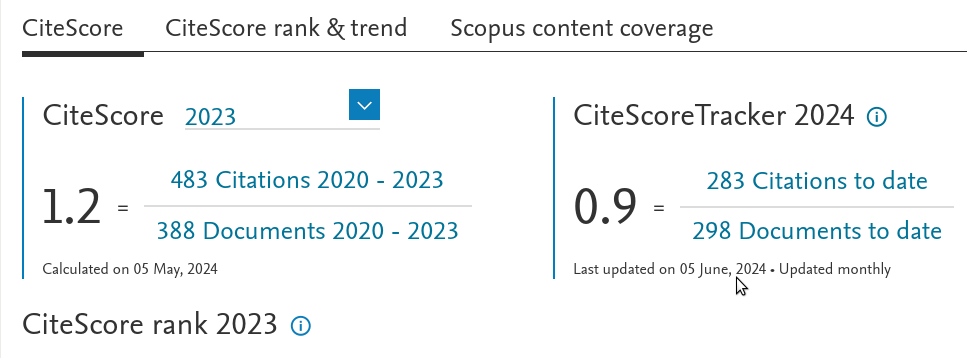Вплив дисперсії четвертого порядку на взаємодію солітонів
DOI:
https://doi.org/10.15407/ujpe65.5.378Ключові слова:
interaction of solitons, non-linearity, dispersion, optical fiber, transmission channel, Schr¨odinger equationАнотація
Солiтони стають важливим фактором у системах оптичного зв’язку завдяки їх стiйкостi. Однак взаємодiя солiтонiв вважається поганим ефектом. Щоб уникнути його, очевидним рiшенням є подiл у часi двох сусiднiх солiтонiв, що визначає швидкiсть передачi двiйкових даних. Однак, є кращi рiшення з малими помилками в швидкостi передачi. Метою даної роботи є вивчення можливостi усунути взаємодiю сусiднiх солiтонiв, використовуючи спецiальну систему управлiння дисперсiєю шляхом введення дисперсiй третього i четвертого порядку при наявностi дисперсiї групової швидкостi. Щоб вивчити їх вплив, вирiшено нелiнiйне рiвняння Шредiнгера методом швидкого фур’є-перетворення. Оригiнальнiсть роботи полягає в спiльному розглядi дисперсiй другого, третього i четвертого порядку для подiлу двух солiтонiв, досить близьких для виникнення ефекту Керра. Це полiпшить їх рух i зменшить помилки в швидкостi передачi. Показано вплив дисперсiї четвертого порядку для 1 солiтону i 2 солiтонiв, що спiльно рухаються з рiзним тимчасовим подiлом, та додатковий ефект вiд введення дисперсiї третього порядку. Показано iснування системи точного управлiння дисперсiєю, яка дозволяє уникнути взаємодiї солiтонiв.
Посилання
T. Yu, E.A. Golovchenko, A.N. Pilipetskii, C.R. Menyuk. Dispersion-managed soliton interactions in optical fibers. Opt. Lett. 22, (11) 793 (1997). https://doi.org/10.1364/OL.22.000793
A. Hasegawa, F. Tappert. I. Anomalous dispersion. Appl. Phys. Lett. 23, 142 (1973). https://doi.org/10.1063/1.1654836
L.F. Mollenauer, R.H. Stolen, J.P. Gordon. Experimental observation of picosecond pulse narrowing and solitons in optical fibers. Appl. Phys. Lett. 45, 1095 (1980). https://doi.org/10.1103/PhysRevLett.45.1095
L.F. Mollenauer, R.H. Stolen. The soliton laser. Optics Letters 9(1), 13(1984). https://doi.org/10.1364/OL.9.000013
B. Guo, Z. Gan, L. Kong, J. Zhang. The Zakharov System and Its Soliton Solutions (Springer, 2016). https://doi.org/10.1007/978-981-10-2582-2
Physics and Applications of Optical Solitons in Fibres '95, Proceedings of the Symposium held in Kyoto, edited by A. Hasegawa (Springer, 1996).
A. Hasegawa, M. Matsumoto. Optical Solitons in Fibers (Springer, 2003). https://doi.org/10.1007/978-3-540-46064-0
L.F. Mollenauer, R.H. Stolen, J.P. Gordon. Experimental observation of picosecond pulse narrowing and solitons in optical fibers. Phys. Rev. 45, 1095 (1980). https://doi.org/10.1103/PhysRevLett.45.1095
J.-P. Wei, J.Wang, X.-F. Jiang, B. Tang. Characteristics for the soliton based on nonlinear Schr¨odinger equation. Acta Photon. Sinica 42(6), 674 (2013). https://doi.org/10.3788/gzxb20134206.0674
N.J. Zabusky, M.D. Kruskal. Interaction of "solitons" in a collisionless plasma and the recurrence of initial states. Phys. Rev. Lett. 15, 240 (1965). https://doi.org/10.1103/PhysRevLett.15.240
G.P. Agrawal. Nonlinear Fiber Optics. (Academic Press, 2007). https://doi.org/10.1016/B978-012369516-1/50011-X
Y. Kodama. Optical solitons in a monomode fiber. J. Stat. Phys. 39, 597 (1985). https://doi.org/10.1007/BF01008354
Y. Kodama, A. Hasegawa. Nonlinear pulse propagation in a monomode dielectric guide. IEEE J. Quantum Electron. 23 (5), 510 (1987). https://doi.org/10.1109/JQE.1987.1073392
B. Guo, Z. Gan, L. Kong, J. Zhang, The Zakharov System and Its Soliton Solutions (Springer, 2016). https://doi.org/10.1007/978-981-10-2582-2
G. Agrawal, R. Boyd. Contemporary Nonlinear Optics. (Academic Press, 1992).
V. Aref. Nonlinear Fourier transform of truncated multi-soliton pulses. In: 12th ITG Conference on Systems, Communications and Coding (SCC), (2019).
A.G. Bakaoukas. An all-optical soliton FFT computational arrangement in the 3NLSE-domain. Nat. Comput. 17(2), 231 (2018). https://doi.org/10.1007/s11047-017-9642-1
C.Y. Yang, W.Y. Li, W.T. Yu, M.L. Liu, Y.J. Zhang, G.L. Ma, M. Lei, W.J. Liu. Amplification, reshaping, fission and annihilation of optical solitons in dispersion-decreasing fiber. Nonlin. Dyn. 92(2), 203 (2018). https://doi.org/10.1007/s11071-018-4049-9
W.J. Liu, C.Y. Yang, M.L. Liu, W.T. Yu, Y.J. Zhang, M. Lei. Effect of high-order dispersion on three-soliton interactions for the variable-coefficients Hirota equation. Phys. Rev. E 96(4), 042201(2017). https://doi.org/10.1103/PhysRevE.96.042201
X. L¨u, W-X. Ma, S-T. Chen, C.M. Khalique. A note on rational solutions to a Hirota-Satsuma-like equation. Appl. Math. Letters 58, 13 (2016). https://doi.org/10.1016/j.aml.2015.12.019
H.N. Xu, W.Y. Ruan, Y. Zhang, X.L¨u. Multi-exponential wave solutions to two extended Jimbo-Miwa equations and the resonance behavior. Appl. Math. Letters 99, 105976 (2020). https://doi.org/10.1016/j.aml.2019.07.007
Y.F. Hua, B.L. Guo, W.X. Ma, X.L¨u. Interaction behavior associated with a generalized (2 + 1)-dimensional Hirota bilinear equation for nonlinear waves. Appl. Math. Model. 74, 184 (2019). https://doi.org/10.1016/j.apm.2019.04.044
Y.H. Yin, W.X. Ma' ГC, J.G. Liu, X. L¨u. Diversity of exact solutions to a (3+1)-dimensional nonlinear evolution equation and its reduction. Comput. Math. Applic. 76, 1275 (2018). https://doi.org/10.1016/j.camwa.2018.06.020
Li-Na Gao, Xue-Ying Zhao, Yao-Yao Zi, Jun Yu, Xing L¨u. Resonant behavior of multiple wave solutions to a Hirota bilinear equation, Comp. Math. Appl. 72 (8), 1225 (2016). https://doi.org/10.1016/j.camwa.2016.06.008
Si-Jia Chen,Yu-Hang Yin, Wen-Xiu Ma, Xing L¨u. Abundant exact solutions and interaction phenomena of the (2 + 1)-dimensional YTSF equation. Anal. Math. Phys. 9, 2329 (2019). https://doi.org/10.1007/s13324-019-00338-2
X. L¨u, W.X. Ma, Y. Zhou, C.M. Khalique. Rational solutions to an extended Kadomtsev-Petviashvili-like equation with symbolic computation. Comp. Math. Appl. 71, 1560 (2016). https://doi.org/10.1016/j.camwa.2016.02.017
H.Q. Zhang, W.X. Ma. Resonant multiple wave solutions for a (3 + 1)-dimensional nonlinear evolution equation by linear superposition principle. Comp. Math. Appl. 73, 2339 (2017). https://doi.org/10.1016/j.camwa.2017.03.014
Y. Yue, L. Huang, Y. Chen. N-solitons, breathers, lumps and rogue wave solutions to a (3+1)-dimensional nonlinear evolution equation. Comp. Math. Appl. 75 (7), 2538 (2018). https://doi.org/10.1016/j.camwa.2017.12.022
E.M.E. Zayed, A.G. Al-Nowehy. The solitary wave ansatz method for finding the exact bright and dark soliton solutions of two nonlinear Schr¨odinger equations. J. Assoc. Arab Univ. Basic Appl. Sci. 24 (1), 184 (2017). https://doi.org/10.1016/j.jaubas.2016.09.003
S.H. Dong. The ansatz method for analyzing Schr¨odinger's equation with three anharmonic potentials in D dimensions. Found. Phys. Lett. 15 (4), 385 (2002).
Wahyulianti, Suparmi, Cari, Fuad Anwar. The solutions of the D-dimensional Schr¨odinger equation for the potential V(r) = ar−6+br−5+cr−4+dr−3+er−2+fr−1. J. Phys. Confer. Ser. 795 (1), 012022 (2017). https://doi.org/10.1088/1742-6596/795/1/012022
K.S. Al-Ghafri, E.V. Krishnan, Anjan Biswas. Optical solitons for the cubic-quintic nonlinear Schr¨odinger equation. AIP Conference Proceedings 2046, 020002 (2018). https://doi.org/10.1063/1.5081522
H. Triki, A.M. Wazwaz. Soliton solutions of the cubicquintic nonlinear Schr¨odinger equation with variable coefficients. Rom. J. Phys. 61 (3-4), 360 (2016). https://doi.org/10.2478/s13531-013-0119-4
M.A. Ablowitz, P.A. Clarkson. Solitons of Nonlinear Evolution Equations and Inverse Scattering (Cambridge Univ. Press, 1991). https://doi.org/10.1017/CBO9780511623998
J. Garnier, K. Kalimeris. Inverse scattering perturbation theory for the nonlinear Schr¨odinger equation with non-vanishing background. J. Phys. A: Math. Theor. 45 (3), 035202 (2012). https://doi.org/10.1088/1751-8113/45/3/035202
S. Randoux, P. Suret, G. El. Inverse scattering transform analysis of rogue waves using local periodization procedure. Sci. Rep. 6, 29238 (2016). https://doi.org/10.1038/srep29238
T. Kawata, N. Kobayashi, H. Inoue. Soliton solutions of the derivative nonlinear Schr¨odinger equation. J. Phys. Soc. Jpn. 46, 1008 (1979). https://doi.org/10.1143/JPSJ.46.1008
B. Prinari, A.K. Ortiz, C. van der Mee, M. Grabowski. Inverse scattering transform and solitons for square matrix nonlinear Sch¨odinger equation. Stud. Appl. Math. 141 (3), 308 (2018). https://doi.org/10.1111/sapm.12223
D. Qiu, J. He, Y. Zhang, K. Porsezian. The Darboux transformation of the Kundu-Eckhaus equation. Proc. R. Soc. A 471, 2180 (2015). https://doi.org/10.1098/rspa.2015.0236
M. Manas. Darboux transformations for the nonlinear Schr¨odinger equations. J. Phys. A Math. Theor. 29 (23), 7721 (1996). https://doi.org/10.1088/0305-4470/29/23/029
S. Xu, J. He, L. Wang. The Darboux transformation of the derivative nonlinear Schr¨odinger equation. J. Phys. A Math. Theor. 44 (30), 305203 (2011). https://doi.org/10.1088/1751-8113/44/30/305203
H.Q. Zhang, M.Y. Zhang, R.Hu. Darboux transformation and soliton solutions in the parity-time-symmetric nonlocal vector nonlinear Sch¨odinger equation. Appl. Math. Lett. 76, 170 (2018). https://doi.org/10.1016/j.aml.2017.09.002
P. Wang, B. Tian, WJ. Liu et al. N-soliton solutions, B¨acklund transformation and conservation laws for the integro-differential nonlinear Schr¨obinger equation from the isotropic inhomogeneous Heisenberg spin magnetic chain, Comput. Math. and Math. Phys. 54 (4), 727 (2014). https://doi.org/10.1134/S0965542514040125
X. L¨u , H.W. Zhu, X.H. Meng, Z.C. Yang, B. Tian. Soliton solutions and a B¨acklund transformation for a generalized nonlinear Schr¨odinger equation with variable coefficients from optical fiber communications. J. Math. Anal. Appl. 336 (2), 1305 (2007). https://doi.org/10.1016/j.jmaa.2007.03.017
H. Eichhorn. B¨acklund transformation and N-soliton solution for the generalized nonlinear Schr¨odinger equation. Annalen der physic 499 (4), 261 (1987). https://doi.org/10.1002/andp.19874990404
Li-Na Gao, Yao-Yao Zi, Yu-Hang Yin, Wen-Xiu Ma, Xing L¨u. B¨acklund transformation, multiple wave solutions and lump solutions to a (3 + 1)-dimensional nonlinear evolution equation. Nonlin. Dyn. 89, 2233 (2017). https://doi.org/10.1007/s11071-017-3581-3
A.P. Fordy. Soliton Theory A Survey of Results (Manchester Univ. Press, 1990).
S. Giulio. Solitons and Particles (World Scientific, 1984).
I.M. Uzunov, V.D. Stoev, T.I. Tzoleva. Influence of the initial phase difference between pulses on the N-soliton interaction in trains of unequal solitons in optical fibers. Optics Comm. 97, 307 (1993). https://doi.org/10.1016/0030-4018(93)90494-P
S. Zentner, L. Sumichrast. Computer simulation of the propagation and interaction of soliton sequences in nonlinear optical fibers. J. Electr. Engin. 52, 57 (2001).
P. Balla, S. Buch, G.P. Agrawal. Effect of Raman scattering on soliton interactions in optical fibers. J. Opt. Soc. Am. B 34, 1247 (2017). https://doi.org/10.1364/JOSAB.34.001247
Y. Kodama, M. Romagnoli, S. Wabnitz, M. Midrio. Role of third-order dispersion on soliton instabilities and interactions in optical fibers. Optics Letters 19 (3), 165 (1994). https://doi.org/10.1364/OL.19.000165
A. Biswas, D. Milovic. Optical solitons with fourth order dispersion and dual-power law nonlinearity. Int. J. Nonlin. Sci. 7 (4), 443 (2009).
M. Pich'e, J.F. Cormier, X. Zhu. Bright optical soliton in the presence of fourth-order dispersion. Optics Lett. 21 (12), 845 (1996). https://doi.org/10.1364/OL.21.000845
M.E.M. Elshater, E.M.E. Zayed, A. Al-Nowehy. Solitons and other solutions to nonlinear Schr¨odinger equation with fourth-order dispersion and dual power law nonlinearity using several different techniques. Eur. Phys. J. Plus. 132 (6), 259 (2017). https://doi.org/10.1140/epjp/i2017-11527-4
J. Xingfang, S. Kai. The influence of the fourth-order dispersion coefficient for the information transmission in fiber. In: Web Information Systems and Mining, edited by Z. Gong, X. Luo, J. Chen, J. Lei, F.L. Wang (Springer, 2011), p. 148. https://doi.org/10.1007/978-3-642-23971-7_21
S. Roy, S.K. Bhadra, G.P. Agrawal. Perturbation of higher-order solitons by fourth-order dispersion in optical fibers. Optics Comm. 282 (18), 3798 (2009). https://doi.org/10.1016/j.optcom.2009.06.018
Downloads
Опубліковано
Як цитувати
Номер
Розділ
Ліцензія
Ліцензійний Договір
на використання Твору
м. Київ, Україна
Відповідальний автор та співавтори (надалі іменовані як Автор(и)) статті, яку він (вони) подають до Українського фізичного журналу, (надалі іменована як Твір) з одного боку та Інститут теоретичної фізики імені М.М. Боголюбова НАН України в особі директора (надалі – Видавець) з іншого боку уклали даний Договір про таке:
1. Предмет договору.
Автор(и) надає(ють) Видавцю безоплатно невиключні права на використання Твору (наукового, технічного або іншого характеру) на умовах, визначених цим Договором.
2. Способи використання Твору.
2.1. Автор(и) надає(ють) Видавцю право на використання Твору таким чином:
2.1.1. Використовувати Твір шляхом його видання в Українському фізичному журналі (далі – Видання) мовою оригіналу та в перекладі на англійську (погоджений Автором(ами) і Видавцем примірник Твору, прийнятого до друку, є невід’ємною частиною Ліцензійного договору).
2.1.2. Переробляти, адаптувати або іншим чином змінювати Твір за погодженням з Автором(ами).
2.1.3. Перекладати Твір у випадку, коли Твір викладений іншою мовою, ніж мова, якою передбачена публікація у Виданні.
2.2. Якщо Автор(и) виявить(лять) бажання використовувати Твір в інший спосіб, як то публікувати перекладену версію Твору (окрім випадку, зазначеного в п. 2.1.3 цього Договору); розміщувати повністю або частково в мережі Інтернет; публікувати Твір в інших, у тому числі іноземних, виданнях; включати Твір як складову частину інших збірників, антологій, енциклопедій тощо, то Автор(и) мають отримати на це письмовий дозвіл від Видавця.
3. Територія використання.
Автор(и) надає(ють) Видавцю право на використання Твору способами, зазначеними у п.п. 2.1.1–2.1.3 цього Договору, на території України, а також право на розповсюдження Твору як невід’ємної складової частини Видання на території України та інших країн шляхом передплати, продажу та безоплатної передачі третій стороні.
4. Строк, на який надаються права.
4.1. Договір є чинним з дати підписання та діє протягом усього часу функціонування Видання.
5. Застереження.
5.1. Автор(и) заявляє(ють), що:
– він/вона є автором (співавтором) Твору;
– авторські права на даний Твір не передані іншій стороні;
– даний Твір не був раніше опублікований і не буде опублікований у будь-якому іншому виданні до публікації його Видавцем (див. також п. 2.2);
– Автор(и) не порушив(ли) права інтелектуальної власності інших осіб. Якщо у Творі наведені матеріали інших осіб за виключенням випадків цитування в обсязі, виправданому науковим, інформаційним або критичним характером Твору, використання таких матеріалів здійснене Автором(ами) з дотриманням норм міжнародного законодавства і законодавства України.
6. Реквізити і підписи сторін.
Видавець: Інститут теоретичної фізики імені М.М. Боголюбова НАН України.
Адреса: м. Київ, вул. Метрологічна 14-б.
Автор: Електронний підпис від імені та за погодження всіх співавторів.

















